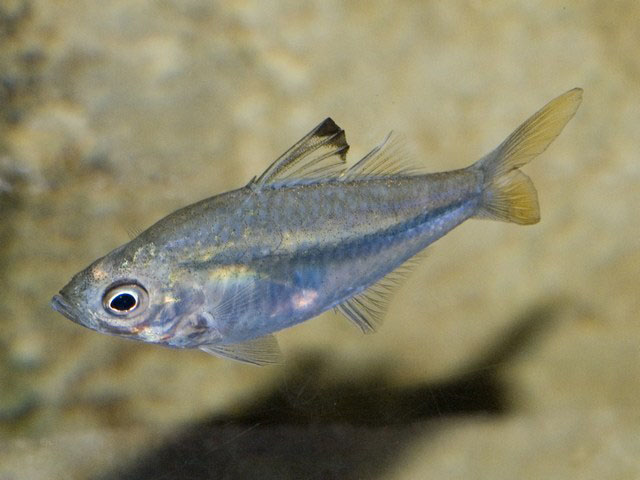
|
Ambassis ambassis (Lacepède, 1802) Commerson's glassy |

|
|
photo by
King, D.R. |
| Family: | Ambassidae (Asiatic glassfishes) | |||
| Max. size: | 15 cm SL (male/unsexed) | |||
| Environment: | demersal; freshwater; brackish; marine, oceanodromous | |||
| Distribution: | Africa: Subtropical eastern South Africa to Kenya, Madagascar, Réunion and Mauritius (Ref. 50956). | |||
| Diagnosis: |
Dorsal spines (total): 8-8; Dorsal soft rays (total): 9-10; Anal spines: 3-3; Anal soft rays: 9-11. Diagnosis: Ambassis ambassis has the following combination of characters: a single supraorbital spine; rostral spine absent; preopercle ridge and rear margin serrate; interopercle edge smooth except for few small serrae at angle; 2-3 rows of cheek scales; predorsal scales 13-18; lateral line continuous (normally); lower gill rakers 19-23; pectoral-fin rays 14-15 (Ref. 50956). Description: Dorsal fin with 8 spines and 9-10 soft rays; anal fin with 3 spines and 9-11 soft rays; pectoral fin with 14-15 rays (Ref. 50956, 52193). Lateral line usually continuous, with 27-31 scales when so, very infrequently 1-2 scales without tubes interrupt lateral line below juncture of dorsal fins; vertical scale rows 29-32; horizontal scale rows 9-10; cheek scale rows 2-3; predorsal scales 13-18 (Ref. 50956). Gill rakers 7-10 + 19-23 (Ref. 50956). A single supraorbital spine; preorbital ridge smooth in early juveniles, becoming serrate by about 35-40 mm standard length; preorbital edge with 5-12 serrae; retrorse rostral spine absent; preopercle ridge with 7-22 serrae; lower edge of preopercle with 12-26 serrae, these extending dorsally along rear margin of preopercle, its entire height in specimens larger than 30 mm standard length; interopercle smooth except for 3-10 minute serrae at angle; teeth in single row on palatines; in three patches on vomer in larger specimens (Ref. 50956). Colouration: Live colouration translucent greenish-brown dorsally, head and abdomen silvery; scales with minute melanophores; membrane between second and third dorsal and anal spines dusky, black at tip; black lineations along bases of unpaired fins; lobes of caudal fin dusky toward upper and lower margins (Ref. 50956). |
|||
| Biology: | Tolerant of freshwater when water temperature is within 7-32°C (Ref. 7248, 79840). Tends to be more tolerant of lower temperatures in water of low salinity (2ppt) than in seawater (Ref. 7248). Feeds at night on crustaceans, fish fry and larvae and insects (Ref. 7248). Salt dried and eaten in some countries (Ref. 12484) | |||
| IUCN Red List Status: | Least Concern (LC); Date assessed: 15 February 2017 Ref. (130435) | |||
| Threat to humans: | harmless | |||